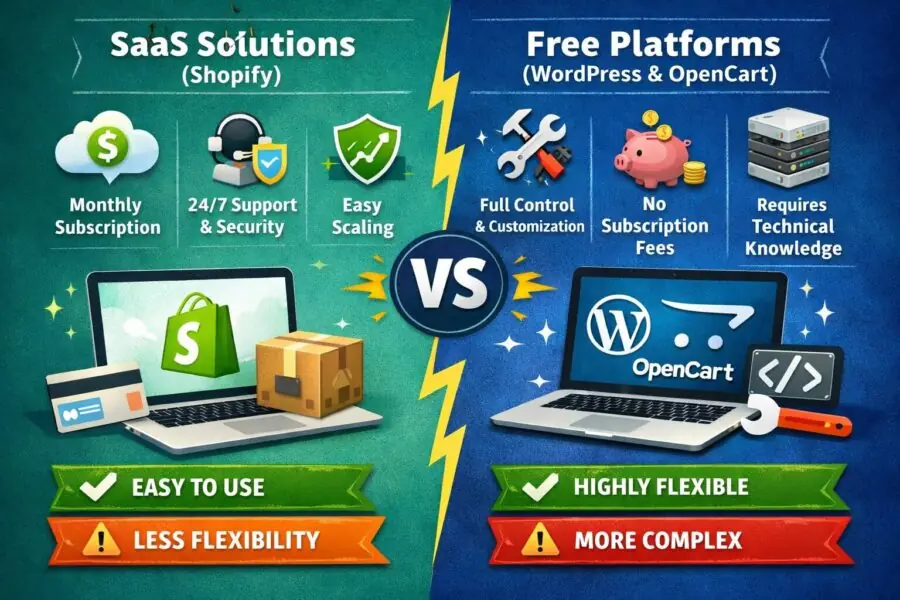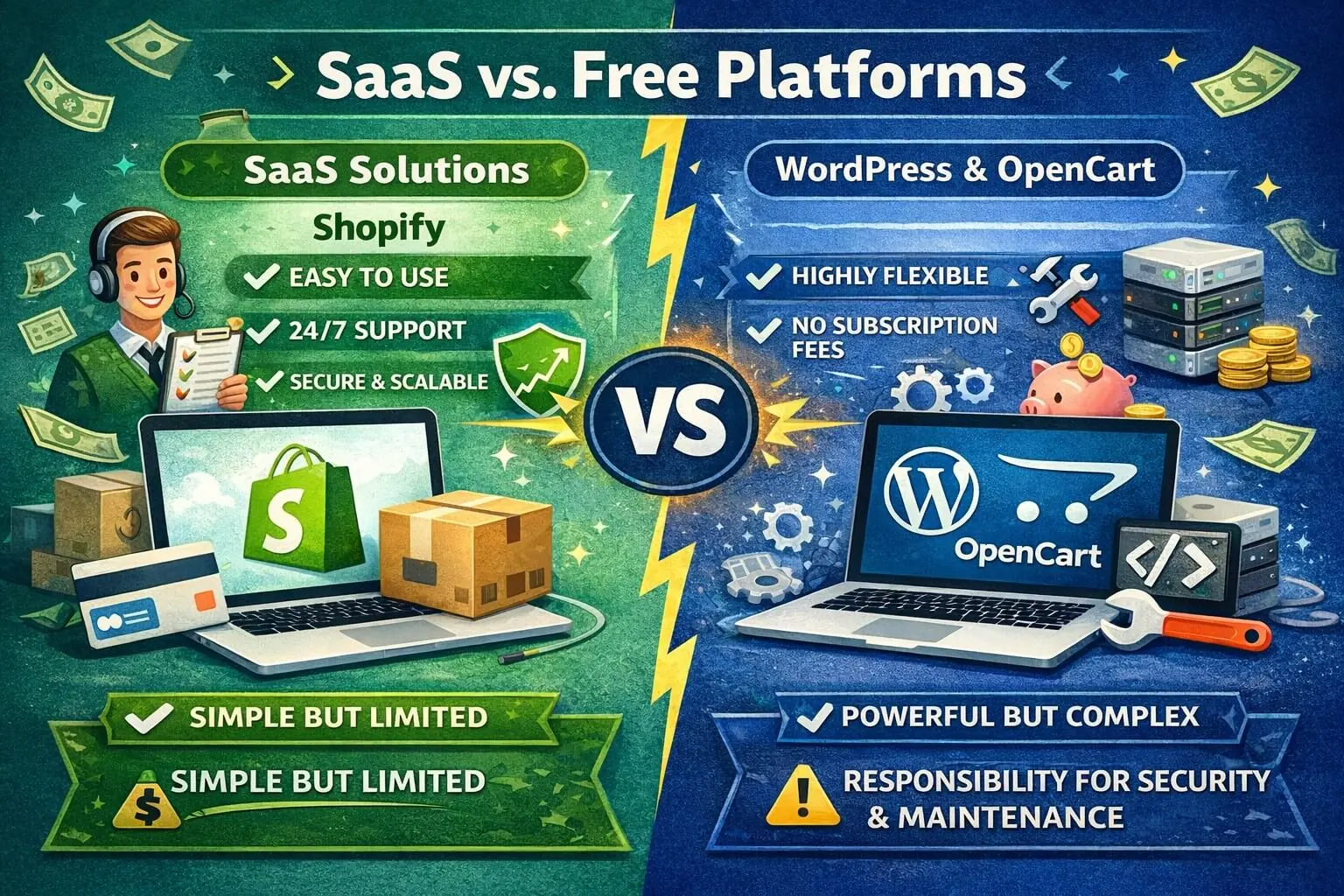
Ready-Made SaaS Solutions, Such as Shopify: Pros and Cons Compared to Free Solutions Like WordPress and OpenCart
Ready-made SaaS solutions like Shopify are powerful platforms for e-commerce, offering a full suite of tools to create and manage online stores. Unlike free CMS platforms such as WordPress or OpenCart, SaaS operates on a subscription model, where users pay for access to services and infrastructure without the need to set up servers or install software. In this article, we will explore the advantages and disadvantages of SaaS solutions compared to free platforms to help you choose the best option for your business.
What Are SaaS Solutions?
SaaS (Software as a Service) is a software distribution model where applications are provided over the internet on a subscription basis. The platform is fully managed by the provider, giving users access to an interface and tools with minimal setup and technical support requirements.
Examples of SaaS for E-Commerce
Shopify is one of the most popular SaaS solutions for creating online stores. It offers a user-friendly interface, a wide range of integrations, and the ability to scale with your business.
Other popular SaaS solutions include:
- BigCommerce — a Shopify alternative aimed at larger e-commerce businesses.
- Squarespace — more focused on design and creative projects but also suitable for small and medium-sized businesses.
- Wix — known for its flexibility in website creation, with built-in e-commerce tools.
Advantages of SaaS Solutions
1. Ease of Use
One of the main advantages of SaaS solutions is the minimal technical knowledge required. Platforms like Shopify offer intuitive interfaces, ready-made templates, and tools for setting up an online store. There’s no need to worry about hosting, security, or updates — all of that is managed by the provider.
2. Guaranteed Technical Support
SaaS platforms offer round-the-clock technical support, which is a big plus for store owners without deep technical expertise. Any operational failures or technical issues are promptly resolved by the support team, reducing the risk of downtime.
3. Security
With SaaS solutions, security is managed at the provider level. Shopify, for example, automatically updates its servers and platform to ensure protection against threats while maintaining PCI DSS compliance for payment data processing.
4. Easy Scaling
If your business grows, SaaS platforms can easily handle increased traffic and order volume. You don’t need to worry about expanding server capacity or configuring additional resources — all of this is automated.
5. Integrations with Payment Systems and Logistics
Many SaaS solutions, like Shopify, offer built-in integrations with popular payment systems, shipping management tools, and analytics services. This simplifies the work for store owners, as there’s no need to search for third-party plugins or worry about compatibility.
Disadvantages of SaaS Solutions
1. Limited Flexibility
SaaS platforms like Shopify offer limited customization options compared to OpenCart or WordPress, which provide open-source code and thousands of plugins. While SaaS platforms offer extensions, the depth of customization and freedom of changes are more limited.
2. Monthly Expenses
SaaS platforms operate on a subscription model, which can be a downside for small businesses with tight budgets. For example, a basic Shopify subscription starts at $39 per month, but access to more advanced features, such as detailed reports and discounts, may require a more expensive plan. Additionally, platforms often charge transaction fees, further increasing operational costs.
3. Dependence on the Provider
When using SaaS solutions, your business is entirely dependent on the provider. If the platform experiences technical difficulties, it will affect your store. Moreover, the platform can change its pricing or usage policies, leading to additional expenses or changes in store operations.
4. Migration Difficulties
If you eventually decide to switch from a SaaS solution to another platform, it can be a complicated and costly process. SaaS platforms often limit data export, making it harder to migrate to other solutions, such as OpenCart or WordPress.
Advantages of Free Solutions (WordPress, OpenCart)
1. Full Control Over Your Store
Free platforms like WordPress with the WooCommerce plugin and OpenCart give you full control over your store and its infrastructure. You can configure the site as you wish, use any plugins, modify the code, and integrate third-party solutions.
2. No Subscription Fees
The software itself for WordPress and OpenCart is free. You only pay for hosting, a domain, and additional services like SSL certificates. This makes them a more economical option for those who can manage the technical aspects.
3. Flexibility and Expandability
With open-source code, WordPress and OpenCart offer thousands of themes, plugins, and modules to add new features. Developers can create custom solutions for the store, integrate specific systems, and customize all aspects of the site’s operation.
Disadvantages of Free Solutions
1. Technical Knowledge Required
WordPress and OpenCart require some technical knowledge to manage the server, install plugins, and configure security. If you lack these skills, you may need to hire developers or system administrators for support.
2. Responsibility for Security and Performance
With free platforms, you are responsible for the store’s security, regular updates, backups, and protection from hacks. The lack of automatic updates and centralized support can lead to vulnerabilities and performance issues.
3. Limited Resources and Scalability
Scaling stores on WordPress and OpenCart can be challenging, especially if the hosting provider cannot handle a large amount of traffic or orders. You will need to manually increase server resources to maintain stable store performance.

Choosing between SaaS solutions and free platforms depends on your business needs, budget, and technical skills. SaaS platforms like Shopify offer ease of use, security, and support, making them an excellent choice for small and medium-sized businesses that want to quickly launch without dealing with technical complexities. However, if you need full control over your store, flexibility, and savings on subscription fees, free solutions like WordPress and OpenCart might be the better alternative.
Growing Online



